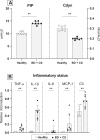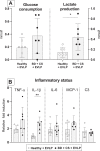A translational rat model for ex vivo lung perfusion of pre-injured lungs after brain death
- PMID: 34855870
- PMCID: PMC8638921
- DOI: 10.1371/journal.pone.0260705
A translational rat model for ex vivo lung perfusion of pre-injured lungs after brain death
Abstract
The process of brain death (BD) detrimentally affects donor lung quality. Ex vivo lung perfusion (EVLP) is a technique originally designed to evaluate marginal donor lungs. Nowadays, its potential as a treatment platform to repair damaged donor lungs is increasingly studied in experimental models. Rat models for EVLP have been described in literature before, yet the pathophysiology of BD was not included in these protocols and prolonged perfusion over 3 hours without anti-inflammatory additives was not achieved. We aimed to establish a model for prolonged EVLP of rat lungs from brain-dead donors, to provide a reliable platform for future experimental studies. Rat lungs were randomly assigned to one of four experimental groups (n = 7/group): 1) healthy, directly procured lungs, 2) lungs procured from rats subjected to 3 hours of BD and 1 hour cold storage (CS), 3) healthy, directly procured lungs subjected to 6 hours EVLP and 4), lungs procured from rats subjected to 3 hours of BD, 1 hour CS and 6 hours EVLP. Lungs from brain-dead rats showed deteriorated ventilation parameters and augmented lung damage when compared to healthy controls, in accordance with the pathophysiology of BD. Subsequent ex vivo perfusion for 6 hours was achieved, both for lungs of healthy donor rats as for pre-injured donor lungs from brain-dead rats. The worsened quality of lungs from brain-dead donors was evident during EVLP as well, as corroborated by deteriorated ventilation performance, increased lactate production and augmented inflammatory status during EVLP. In conclusion, we established a stable model for prolonged EVLP of pre-injured lungs from brain-dead donor rats. In this report we describe tips and pitfalls in the establishment of the rat EVLP model, to enhance reproducibility by other researchers.
Conflict of interest statement
The authors have declared that no competing interests exist.
Figures








Similar articles
-
Male versus female inflammatory response after brain death model followed by ex vivo lung perfusion.Biol Sex Differ. 2024 Jan 29;15(1):11. doi: 10.1186/s13293-024-00581-8. Biol Sex Differ. 2024. PMID: 38287395 Free PMC article.
-
Ex Vivo Perfusion With Methylprednisolone Attenuates Brain Death-induced Lung Injury in Rats.Transplant Direct. 2021 Mar 16;7(4):e682. doi: 10.1097/TXD.0000000000001141. eCollection 2021 Apr. Transplant Direct. 2021. PMID: 33748411 Free PMC article.
-
Lungs donated after circulatory death and prolonged warm ischemia are transplanted successfully after enhanced ex vivo lung perfusion using adenosine A2B receptor antagonism.J Thorac Cardiovasc Surg. 2017 Nov;154(5):1811-1820. doi: 10.1016/j.jtcvs.2017.02.072. Epub 2017 Apr 12. J Thorac Cardiovasc Surg. 2017. PMID: 28483262 Free PMC article.
-
The Conversional Efficacy of Ex Vivo Lung Perfusion and Clinical Outcomes in Patients Undergoing Transplantation of Donor Lungs by Ex Vivo Lung Perfusion: A Meta-Analysis.Ann Transplant. 2019 Dec 27;24:647-660. doi: 10.12659/AOT.919242. Ann Transplant. 2019. PMID: 31879416 Free PMC article.
-
Ex-vivo lung perfusion.Curr Opin Anaesthesiol. 2020 Feb;33(1):50-54. doi: 10.1097/ACO.0000000000000804. Curr Opin Anaesthesiol. 2020. PMID: 31688085 Review.
Cited by
-
Design and Implementation of a Rat Ex Vivo Lung Perfusion Model.J Vis Exp. 2023 May 26;(195):10.3791/64740. doi: 10.3791/64740. J Vis Exp. 2023. PMID: 37306411 Free PMC article.
-
Male versus female inflammatory response after brain death model followed by ex vivo lung perfusion.Biol Sex Differ. 2024 Jan 29;15(1):11. doi: 10.1186/s13293-024-00581-8. Biol Sex Differ. 2024. PMID: 38287395 Free PMC article.
-
Experimental Models of Ischemic Lung Damage for the Study of Therapeutic Reconditioning During Ex Vivo Lung Perfusion.Transplant Direct. 2022 Jun 10;8(7):e1337. doi: 10.1097/TXD.0000000000001337. eCollection 2022 Jul. Transplant Direct. 2022. PMID: 35702630 Free PMC article.
References
-
- Cypel M, Yeung JC, Donahoe L, et al.. Normothermic ex vivo lung perfusion: Does the indication impact organ utilization and patient outcomes after transplantation? J Thorac Cardiovasc Surg 2020; 159: 346–355.e1. - PubMed
Publication types
MeSH terms
Substances
LinkOut - more resources
Full Text Sources

